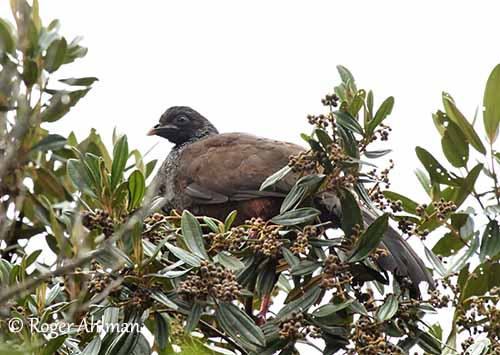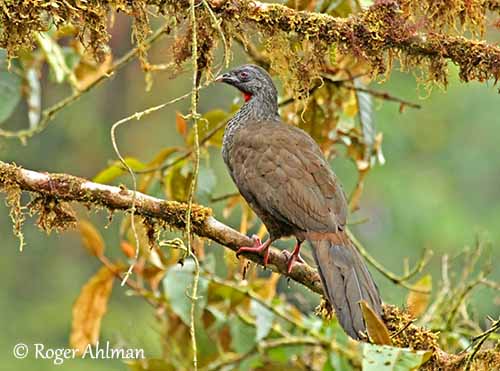
Fr : Pénélope des Andes
Ang : Andean Guan
All : Andenguan
Esp : Pava Andina - Pava de monte andina
Ita : Penelope delle Ande
Nd : Andessjakohoen
Sd : Andinsk guan
Photographers:
Roger Ahlman
Pbase Galleries Peru and Ecuador
Didier Buysse
Vision d’Oiseaux
Otto Plantema
Trips around the world
Text by Nicole Bouglouan
Sources:
HANDBOOK OF THE BIRDS OF THE WORLD Vol 2 by Josep del Hoyo-Andrew Elliot-Jordi Sargatal - Lynx Edicions - ISBN: 8487334156
OPEPA - Pava andina - Penelope montagnii
Descripción de un volantón y aspectos comportamentales de la Pava Andina
Biodiversitad y Conservación - Cerros al oriente de Bogotá - El regreso de la pava de monte
Wikipedia, the free encyclopaedia
Andean Guan
Penelope montagnii
Galliformes Order – Cracidae Family
INTRODUCTION:
The Andean Guan is included in the subfamily Penelopinae in the family Cracidae, alongside the chachalacas and other guan species. The genus Penelope is a fairly homogenous group of arboreal birds, but not very specialized birds. They inhabit the cloud forests in mountains at high elevations.
The Andean Guan is threatened by the destruction of the habitat through heavy deforestation and fragmentation in its altitudinal range, involving population’s decline.
DESCRIPTION OF THE BIRD:
Biometrics:
Length: 50-60 cm
Weight: 820-840 g
The Andean Guan is relatively small, similar in size to a chicken. It has long neck and tail, and partially feathered throat and tarsi.
It has brown plumage overall, but head, neck and breast feathers show whitish edges. The upperparts are brown, including the uppertail-coverts contrasting with the duller brown tail. The flight feathers are dull brown too.
The underparts are mostly reddish on belly, vent and undertail-coverts.
The head is paler than neck and breast, with greyish-white forehead, supercilium, ear-coverts and cheeks. The bare skin of lores and eyering is grey. We can see a bright red wattle hanging from the throat.
The bill is grey with pale tip. The eyes are reddish-brown. Legs and feet are pinkish-red.
Both adults are similar.
The juvenile resembles adult but it has browner plumage with weak vermiculations on the underparts, and paler sides of face and throat.

SUBSPECIES AND RANGE:
The Andean Guan has five recognized subspecies.
P.m. montagnii (described above) is found in NW Venezuela and N & C Colombia.
P.m. atrogularis occurs on W slope of Andes in S Colombia and Ecuador. This race has less extensive and fluffier throat feathers than nominate.
P.m. brooki is found on E slope of Andes in S Colombia and Ecuador. This one has blacker and fluffier upperparts than the two previous.
P.m. plumosa occurs on E slope of Andes in Peru. This race has more rufescent underparts than the other races.
P.m. sclateri occurs in Yungas of Bolivia S to Santa Cruz. This one has duller upperparts and more rufescent underparts. There is an obvious silvery supercilium and less feathering on throat.
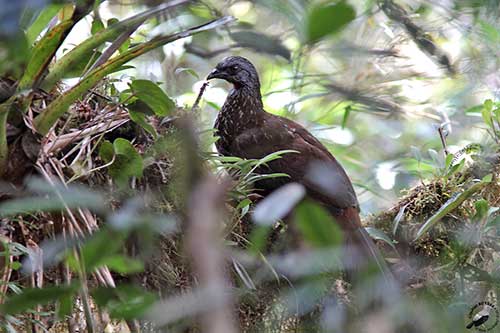
HABITAT:
The Andean Guan frequents thick cloud forests in mountains, in temperate zone up to 3700 metres of elevation. However, it is sometimes observed in subtropical mountain zone, as low as 1500 metres in Peru and 1200 metres in Bolivia. It can be occasionally found in tall second growth and open areas with fruiting trees.
The Andean Guan usually occurs at higher elevations than other Cracidae species. But it can be seen sometimes in woodlands in the vicinity of cities such as Bogotá.
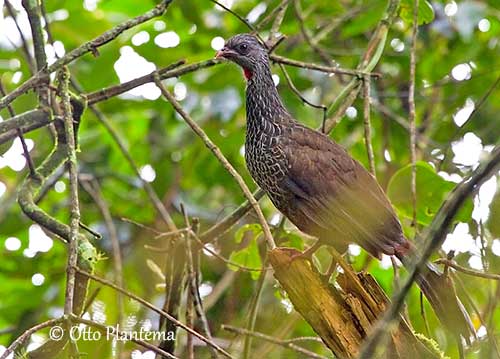
CALLS AND SONGS: SOUNDS BY XENO-CANTO
Like other guans, the Andean Guan produces wing-drumming displays usually preceded by soft whistle. These typical sounds are often accompanied by other calls including series of rasping and crowing notes, interspersed with higher sounds when the bird is alarmed.
Other long series of low notes are given in early morning and late afternoon “chaah-choah-cha-cha-choam-cha-cha-cha…” and at dusk, we can hear a soft “cluit cluir lui lui luir”.
The calls are mainly given in territorial behaviour, whereas the wing-drumming is mainly related to courtship.
This strange noise is due to the modification of the distal 5-8 centimetres of the quills on the 3 or 4 outermost primary flight feathers.
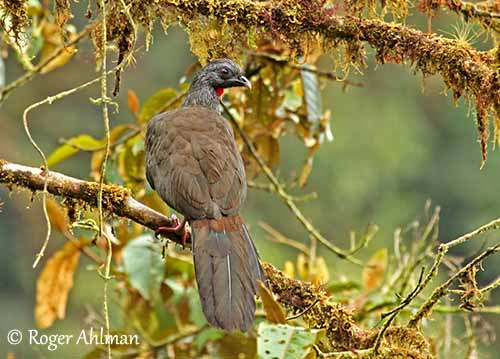
BEHAVIOUR IN THE WILD:
The Andean Guan feeds on plant matter such as fruit with seeds, other seeds and leaf parts. It feeds mainly on fruits of Lauraceae of genus Ocotea, Nectandra, Aiouea and Aniba.
This species is threatened by deforestation involving reduction of fruiting trees. However, it has adapted to smaller forest patches, probably due to the variable diet of these birds.
It often forages in groups of 3-12 individuals, but sometimes alone too. It can be seen climbing and walking into the high branches of fruiting trees, from mid to upper level in trees. It occasionally comes to the ground to drink and feed, but it is mainly arboreal.
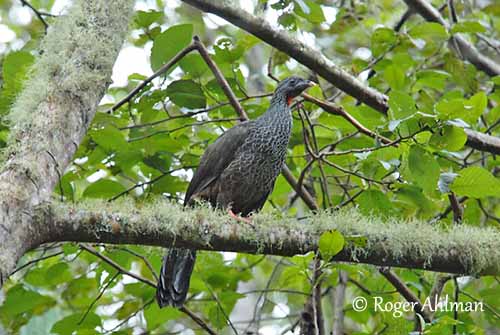
During the breeding season, the Andean Guan performs some displays unique among the Cracidae, the wing-drumming or wing-whirring displays. This behaviour can be observed all year round, but more intense during the breeding season.
This display is performed before dawn, when it is still dark in the forest and during a special flight. The bird takes off from a perch, usually in tall emergent tree, and glides in the air during two seconds. It produces the wing-whir during three seconds with wingbeats twice as fast as in usual flight. Then, it glides and reaches another similar but lower perch. These aerial displays are performed over 50-175 metres in the open.
These displays can be repeated several times, using different perches. We can hear some soft whistles before the wing-drumming. This behaviour stops before dawn.
The modifications of the wing quills are present in both sexes, but usually, these displays are performed by the male in presence of its mate.
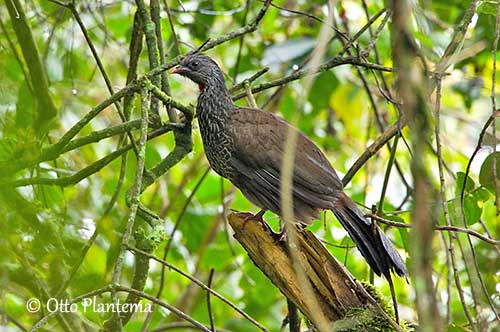
The Andean Guan is sedentary, but seasonal movements occur according to fruit availability.
It flies well, flying from tree to tree while foraging, with wingbeats interspersed with glides.
REPRODUCTION OF THIS SPECIES:
The breeding season varies depending on the range. It occurs in February/March in Venezuela and Colombia and probably between November and February in Bolivia.
The Andean Guan breeds in cloud forest in mountains. The nest is a platform made with twigs and sticks, and lined with leaves. It is placed high in tree.
The female lays two eggs and incubates alone while the male remains in the surrounding and protect the nest-site. The duration of this period is unknown but in some other guan species, the incubation lasts 28 days.
The chick has black head with white band from bill to nape. It has brownish down, darker brown wings with rufous wingbar. On the underparts, throat and upperbreast are rufous, while belly and flanks are buffy-white. The short tail is dark brown. The bill is horn-coloured. The eyes are dark brown with yellowish eyering. Legs and feet are yellowish.
No more information.
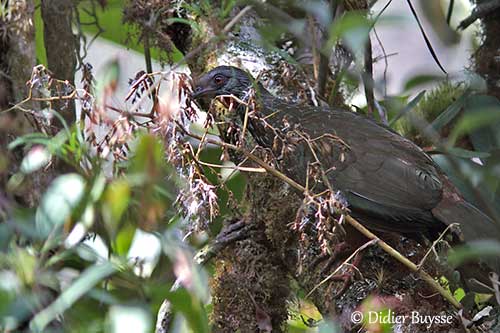
PROTECTION / THREATS / STATUS:
The Andean Guan is affected by habitat destruction and hunting, but the species is still common in some parts of its range. It may adapt to smaller highland forest patches and tolerate some habitat alteration. It is present in protected areas including National parks.
The Andean Guan is currently evaluated as Least Concern.
